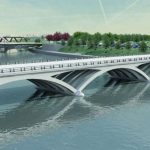 A little while ago there was a big splash made by news that the world’s first 3d printed bridge had been constructed in Amsterdam. Whilst that was undoubtedly pretty cool, a potentially greater breakthrough was revealed by a team of Warwick University researchers in a recent paper.
A little while ago there was a big splash made by news that the world’s first 3d printed bridge had been constructed in Amsterdam. Whilst that was undoubtedly pretty cool, a potentially greater breakthrough was revealed by a team of Warwick University researchers in a recent paper.
It describes what the authors believe are a new generation of indestructible bridges that take their inspiration from the natural world.
The next wave of form-finding
Form-finding is a commonly used design process that enables man-made structures to follow a strong and natural form. So, for instance, structures that are sustained by pure compression that have no bending stresses.
The team believe that taking this process to its limit could produce bridges, and other buildings, that are capable of withstanding any possible load without the need for regular repair and maintenance.
The researchers examined a multitude of natural objects to explore how they develop stress patterns to withstand the various forces they’re subjected to.
They integrated their findings into a mathematical model that they believe will help to produce stronger structures that existing man-made designs that perhaps focus too much on aesthetics over structure.
“Aesthetics is an important aspect of any design, and we have been programmed to view some shapes, such as circular arches or spherical domes as aesthetic. We often build them regardless of the fact that they generate complex stresses, and are, therefore, structurally inefficient,” the researchers say.
The new model suggests that we may finally have cracked the age old architectural problem of how to construct the perfect arch. Time will tell if it actually finds its way into the next generation of bridges built around the world.
I wonder if that's like that well known unsinkable ship, the Titanic?